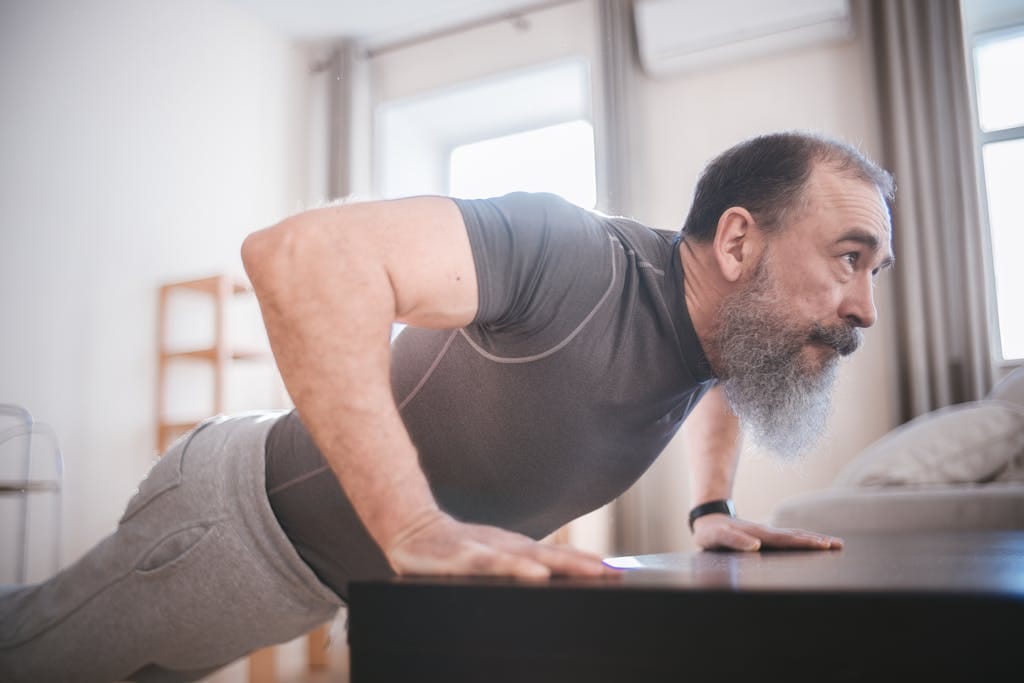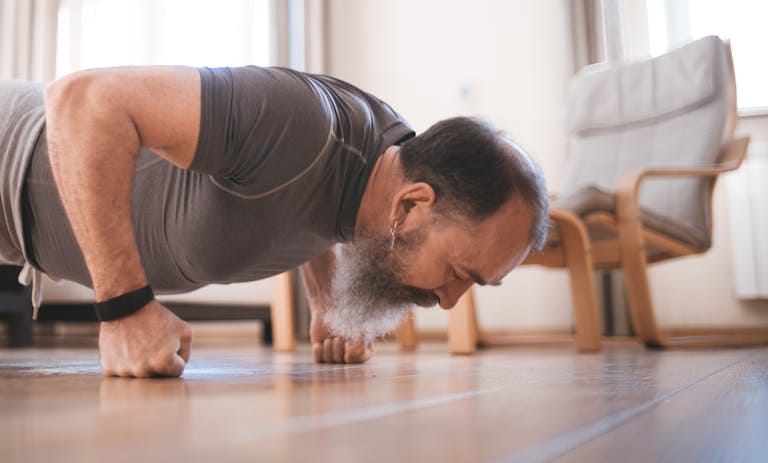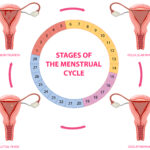FREE SHIPPING OVER $50
The Pushup Test: Can You Out-Perform 90% of People Over 40?

Turning 40 often brings a new perspective on fitness. Suddenly, it’s not just about looking good, but feeling strong, staying active, and maintaining the kind of physical ability that allows you to enjoy life to the fullest. You might start wondering, “Am I still as strong as I used to be?” or “How do I compare to others my age?”
Well, there’s a simple, universally recognized exercise that can give you a quick, honest answer: the pushup. It’s a fantastic measure of upper body strength, core stability, and overall functional fitness. And today, we’re going to put it to the test.
Can you out-perform a significant majority of people over 40 when it comes to pushups? Let’s dive into “The Pushup Test,” discover the number that truly sets you apart, and arm you with the knowledge to build the strength that defies age.
Can You Out-Perform 90% of People Over 40? Here’s the Number
Based on various fitness assessments and strength norms for individuals in their 40s (assuming proper pushup form – chest to the floor, body in a straight line, no sagging hips or piking up), here’s what puts you in a highly respectable category, outperforming a significant portion of your peers:
- For Men (Ages 40-49):
- Good Fitness: 13-24 pushups
- Excellent Fitness (Outperforming Most): 25+ pushups
- If you can consistently complete 25 or more pushups with good form, you are demonstrating upper body strength and core stability that truly puts you in an elite category for men over 40.
- For Women (Ages 40-49):
- Good Fitness: 8-14 pushups
- Excellent Fitness (Outperforming Most): 15+ pushups
- If you can consistently complete 15 or more pushups with good form, you are showcasing exceptional strength that many women your age would envy.
What This Number Means for Your Health and Fitness:
Achieving these “excellent” numbers isn’t just about bragging rights. It signifies:
- Robust Upper Body Strength: You have strong chest, shoulder, and tricep muscles.
- Solid Core Stability: Your core muscles are engaged and capable of maintaining a rigid spine.
- Good Body Control: You possess the coordination and control to move your body through space effectively.
- Reduced Risk of Functional Decline: Maintaining this level of strength means you’re more likely to enjoy independence and physical capability as you continue to age.
So, how did you do on “The Pushup Test?” Whether you hit these numbers or have some work to do, the good news is that pushup strength is entirely trainable!
Mastering the Pushup: Your Path to Outperforming the Rest
If you’re not quite at those “elite” numbers yet, don’t sweat it! The journey to stronger pushups is a progressive one, and anyone can improve with consistency and the right approach. The key is to start where you are and gradually build your strength.
Before you begin, remember: Proper form is paramount. Doing fewer pushups with perfect form is always better than doing many with sloppy technique.
- Good Pushup Form Checklist:
- Straight Line: Keep your body in a straight line from head to heels, no sagging hips or piking up.
- Engaged Core: Tighten your abdominal muscles throughout the movement.
- Elbow Angle: Your elbows should point back at about a 45-degree angle to your body, not flared out directly to the sides.
- Full Range of Motion: Lower your chest until it’s just above the floor (or to the level you can maintain good form), then push back up until your arms are fully extended.
Pushup Progression Guide
Here’s a pushup progression guide to help you build strength step-by-step:
- Wall Pushups:
- How to do it: Stand facing a wall, about arm’s length away. Place your hands on the wall slightly wider than shoulder-width apart. Lean into the wall, bending your elbows until your nose or chest is close to the wall. Push back to the starting position.
- Why it works: This is the easiest modification, reducing the amount of bodyweight you’re pushing. It allows you to practice the form and build foundational strength.
- Incline Pushups:
- How to do it: Place your hands on an elevated surface like a sturdy kitchen counter, a bench, or a low box. The higher the surface, the easier the pushup. Perform the pushup with proper form.
- Why it works: Gradually increases the amount of bodyweight you’re lifting as you lower the incline. This is a crucial step towards getting to the floor.
- Knee Pushups:
- How to do it: Get on your hands and knees. Walk your hands forward until your body forms a straight line from your head to your knees (not your feet). Perform the pushup, keeping your core engaged and your back straight.
- Why it works: Reduces the overall load significantly while still allowing you to practice the full range of motion on the floor.
- Negative Pushups:
- How to do it: Start in a full plank position (or knee plank if needed). Slowly lower your body down to the floor, taking 3-5 seconds. Once your chest touches, push back up from your knees, or simply return to the starting plank position to begin the next “negative.”
- Why it works: Builds eccentric strength (the lowering phase of the movement), which is vital for building the power to push yourself back up.
- Standard Pushups:
- How to do it: Start in a high plank position, hands slightly wider than shoulder-width apart, body in a straight line from head to heels. Lower your chest towards the floor, keeping your elbows tucked at about 45 degrees. Push back up forcefully to the starting position.
- Why it works: This is the full-body strength test we’re aiming for!
- Advanced Variations (for the truly strong): Once you master standard pushups, you can explore variations like decline pushups (feet elevated), weighted pushups (with a plate on your back), or even single-arm pushups for continued strength gains.
Beyond the Pushup Count: Why This Strength Matters as You Age
Achieving and maintaining pushup strength isn’t just about hitting a number; it’s about investing in your long-term health and quality of life. As you progress, you’ll notice profound benefits that extend far beyond your workout routine:
- Enhanced Functional Independence: The ability to push, brace, and move your own bodyweight translates directly into easier daily activities – from gardening to playing with grandkids, or simply getting up off the floor without assistance.
- Improved Bone Density: Bodyweight exercises like pushups are a form of weight-bearing exercise, which is crucial for stimulating bone growth and helping to combat osteoporosis, a common concern as we age.
- Boosted Metabolism and Body Composition: More muscle mass means a higher resting metabolism, which helps with weight management. Plus, building strength improves your body composition by reducing fat mass and increasing lean muscle.
- Reduced Risk of Injury: A strong core and upper body provides better support for your spine and joints, reducing the risk of injuries from falls or everyday strains.
- Increased Confidence and Vitality: Feeling strong and capable profoundly impacts your mental well-being. It boosts confidence, reduces stress, and contributes to a more energetic and vibrant life.
Your Pushup Training Plan: Consistency, Progression, and Patience
Ready to take on the pushup test and build age-defying strength? Here’s how to structure your training:
- Consistency is Key: Aim for 2-3 pushup training sessions per week. Allow at least one day of rest between sessions for muscle recovery and growth.
- Progressive Overload: This is how you get stronger. Once you can comfortably perform 3 sets of 10-12 repetitions of a specific pushup variation with good form, it’s time to move to the next, more challenging progression. Don’t rush it!
- Listen to Your Body: If you feel pain, stop. Don’t push through sharp or persistent discomfort. It’s important to differentiate between muscle fatigue (good) and joint pain (bad).
- Holistic Approach: Remember that pushups are part of a larger fitness picture. Complement your pushup training with other strength exercises (for lower body and back), cardio, a balanced diet rich in protein, and adequate sleep for optimal recovery.
- Patience and Persistence: Building strength takes time and consistency. Don’t get discouraged if progress isn’t instant. Celebrate every small improvement along the way.
Take the Pushup Test: Build Lasting Strength, Outperform Your Peers
The pushup test isn’t just about proving something to others; it’s about understanding your own strength and taking charge of your fitness as you age. Hitting that benchmark for individuals over 40 means you’re actively resisting the common decline in strength and choosing a path of continued vitality.
So, go ahead. Try the test. See where you stand. And then, armed with the knowledge of how to progress, commit to building that age-defying strength. Your body, your mind, and your future self will thank you for it. You absolutely can outperform your peers and enjoy a stronger, more capable life!
Related Articles
- Sculpt Your Six-Pack at Home: Just 10 Minutes, Zero Equipment Needed!
- Get Boulder Shoulders: 4 Simple Exercises for Powerful, Defined Delts
- Unlock Your Best Workout: Cardio Before or After Weights? The Surprising Truth from New Research
- Can YOU Bench 225 Lbs? The True Benchmark of Strength (Are You Strong Enough?)
- Torch Your Glutes With This Physical Therapist-Approved Workout Finisher







